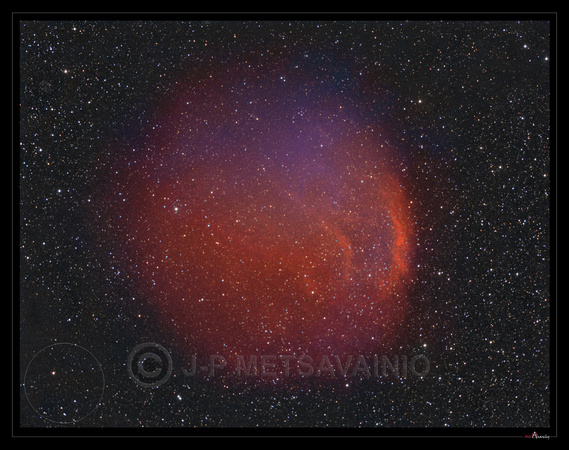Sh2-216, A planetary Nebula in Perseus
Sh2-216, A planetary Nebula in Perseus, the closest PN to Earth ever discovered!
Ra 04h 45m 35s Dec +46° 48′ 30"
Natural color composition from the emission of ionized elements, R=80%Hydrogen+20%Sulfur, G=100%Oxygen and B=85%Oxygen+15%Hydrogen to compensate otherwise missing H-beta emission. This composition is very close to a visual spectrum.
Sharpless 216, Sh2-216 (aka Simeis 288, Marsalkova 44, LBN 742, GN 04.41.3) is a closest known planetary nebula to Earth, about 390 light years, and also one of the oldest known. Due the old age, it's very diffused, dim and large, apparent diameter is about 1,6 degrees. (Full Moon is about 0,5 degrees wide)
In this image, three emission lines are shown. Ionized Hydrohen (H-a) as Green, ionized Sulfur (S-II) as Red and ionized Oxygen (O-III) as Blue.
S-II region seems to be more expanded than H-a region, O-II is mainly in upper part of the PN but there is some at Right, at between the hydrogen filaments. H-a seems to be little more expanded at the Left side of the nebula, much more dimmer, than a Right side though.
This must be one of the dimmest targets I ever have shot!
I never have seen this target as a three band emission color image before, as far as I know, this must be the first! Generally there is very few images of this to compare, please, let me know, if you have seen this before as a narrowband three color image.
Processing work flow:
Image acquisition, MaxiDL v5.07.
Stacked and calibrated in CCDStack.
Levels, curves and color combine in PS CS3.
Equipments:
Tokina AT-X 300mm f2.8 @ f2.8
Platform and guiding, Meade LX200 GPS 12" @ f5
Camera, QHY9
Guider, Lodestar
Image Scale, 3,79 arc seconds/pixel
Exposures:
Baader H-alpha 7nm 30x1200s, binned 1x1
Baader O-III 8,5nm 17x600s, binned 2x2
Baader S-II 8nm 25x600s, binned 2x2
Total exposure time 17h


